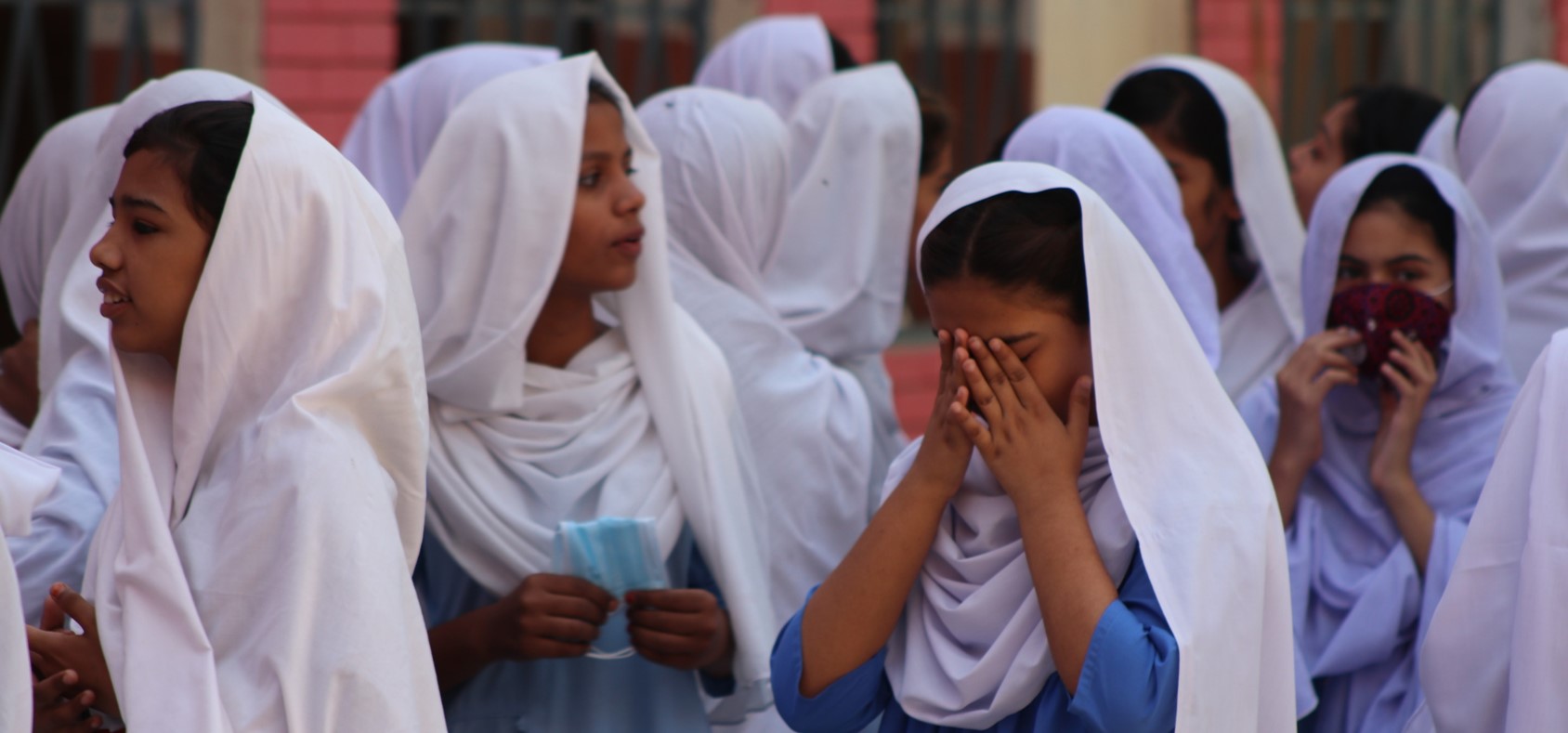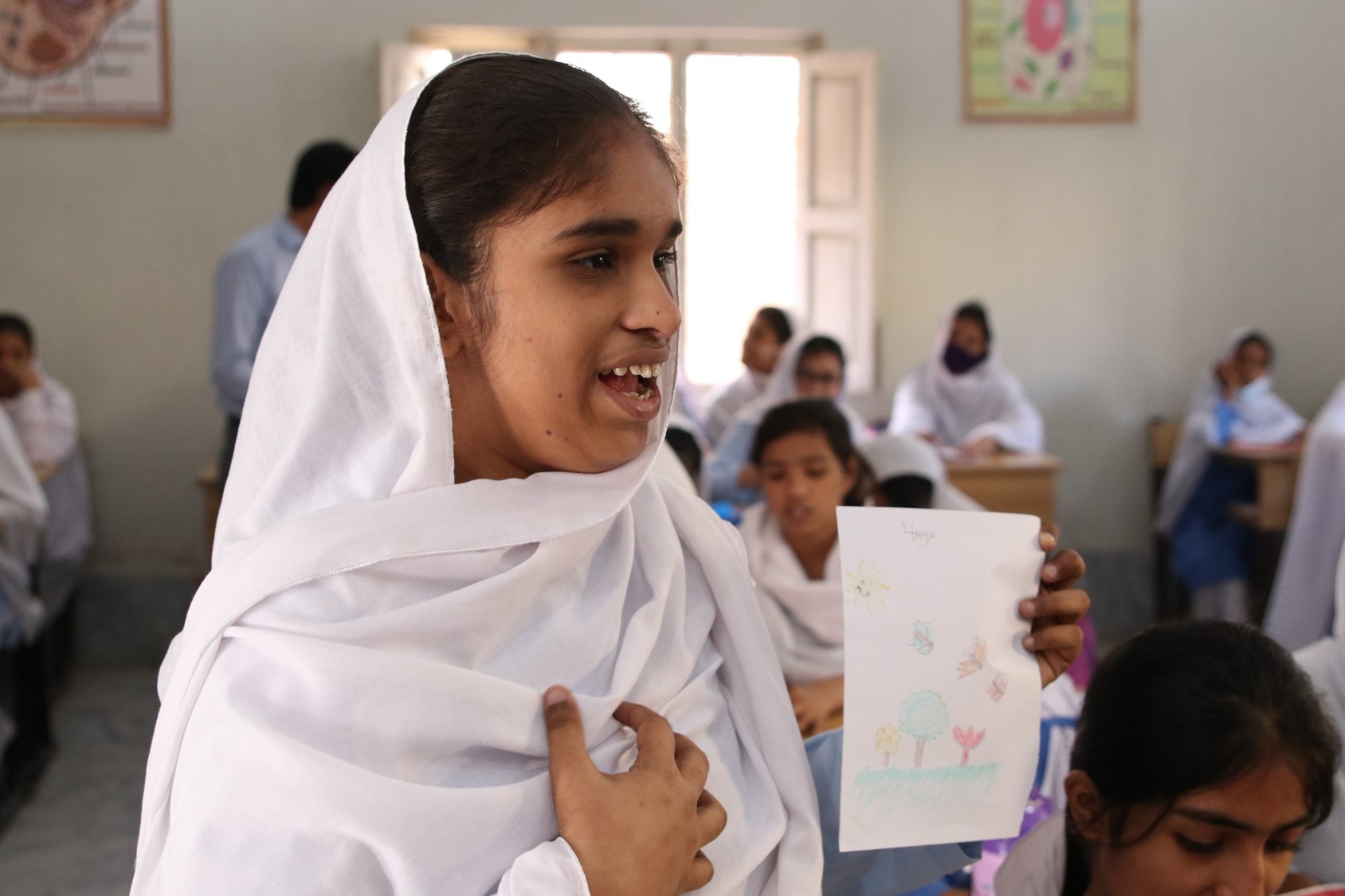
Mission
Girl Rising’s mission is to use the power of storytelling to change the way the world values girls and their education.
Life Challenges of the Women Served
Adolescents in the underserved Khairpur district of Sindh, Pakistan, especially girls, lack access to quality education and social emotional learning (SEL). More than 10 million Pakistani girls are not in school, and boys outnumber girls at every stage of education. In Sindh, only 42 percent of girls attend school. By grade nine, only 13 percent are enrolled. During secondary schooling, a critical time to invest in girls’ life skills, girls are often taken out of school for marriage, labor, or to manage household chores and become caretakers. Girls who live and study in environments hostile to their development grow up with poor self-confidence and lack agency to advocate for themselves.
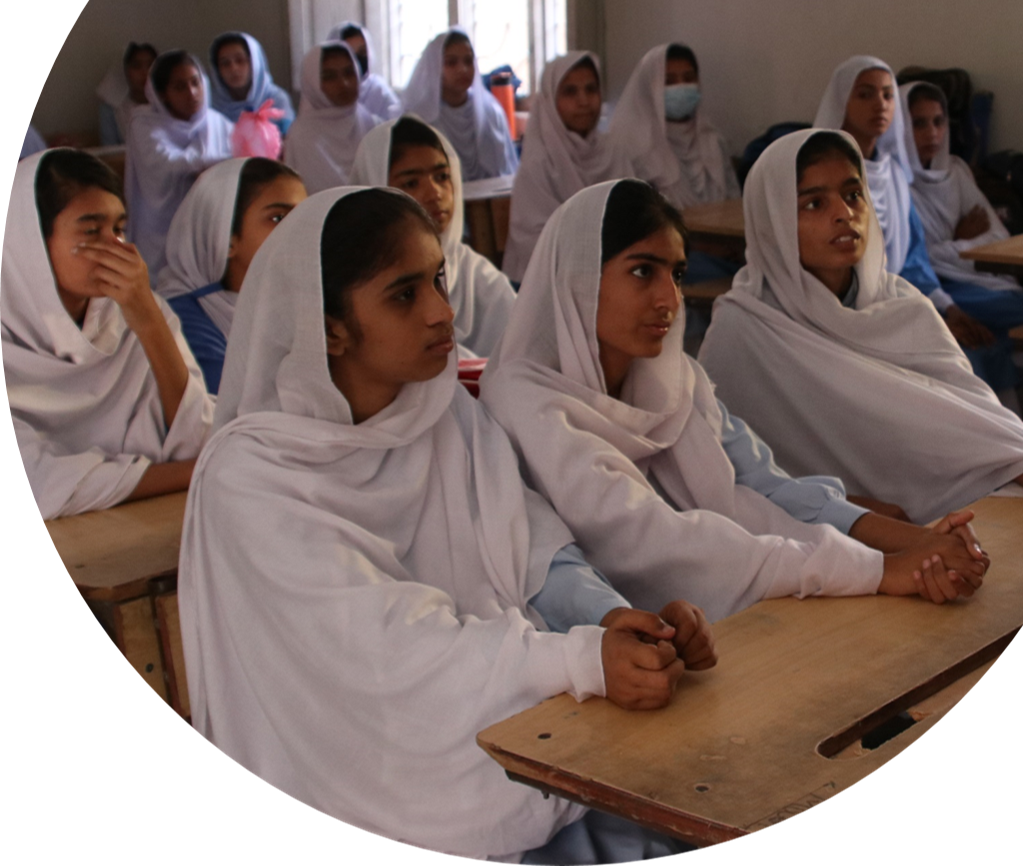 Numerous political, economic, and socio-cultural factors lie at the heart of this problem: pervasive gender stereotypes, stereotypical approaches to education, and a lack of infrastructure, awareness of girls’ menstrual health and hygiene, and parental engagement. Even when girls are able to attend school, they often endure discriminatory gender norms, mental health problems, child marriage, and violence. Many Pakistani families prefer to educate boys over girls to serve as a source of financial support. The lack of sanitation facilities at educational institutions and the pervasive silence around menstrual hygiene results in a high dropout rate of girls in secondary school as they start menstruating. Many families complain about the poor quality of education, with issues ranging from overcrowding, teacher absenteeism, and poorly educated and underqualified teachers. As a result, parents find greater value in keeping children at home or engaging them in paid work, which for girls usually means domestic work, sewing, embroidery, or housework as caregivers of their families.
Numerous political, economic, and socio-cultural factors lie at the heart of this problem: pervasive gender stereotypes, stereotypical approaches to education, and a lack of infrastructure, awareness of girls’ menstrual health and hygiene, and parental engagement. Even when girls are able to attend school, they often endure discriminatory gender norms, mental health problems, child marriage, and violence. Many Pakistani families prefer to educate boys over girls to serve as a source of financial support. The lack of sanitation facilities at educational institutions and the pervasive silence around menstrual hygiene results in a high dropout rate of girls in secondary school as they start menstruating. Many families complain about the poor quality of education, with issues ranging from overcrowding, teacher absenteeism, and poorly educated and underqualified teachers. As a result, parents find greater value in keeping children at home or engaging them in paid work, which for girls usually means domestic work, sewing, embroidery, or housework as caregivers of their families.
Another pressing cause of abysmal educational outcomes is a lack of meaningful youth engagement and freedom of expression. Only 15 percent of Pakistani adolescents indicate they are able to discuss their issues with friends and family, and only 17 percent participate in youth groups or sports. A majority of youth report a lack of an enabling environment, both at home and in schools, that facilitates sharing of views, encourages decision-making, and nurtures community engagement.
Not addressing gender-based discrimination and building SEL skills in students is creating a mass of young people with low rates of SEL outcomes, high unemployment, and an inability to determine non-traditional career paths. Pursuing a career is not a viable option for girls who are married before attaining adulthood. In Sindh, the incidence of girl child marriage has increased in the recent past. Furthermore, the absence of a learning environment that equips young people, who constitute 29 percent of Pakistan’s population, with social-emotional skills to meaningfully engage in their communities, is perpetuating a wave of intolerance that is threatening the country’s equilibrium and the social and emotional health of its people.
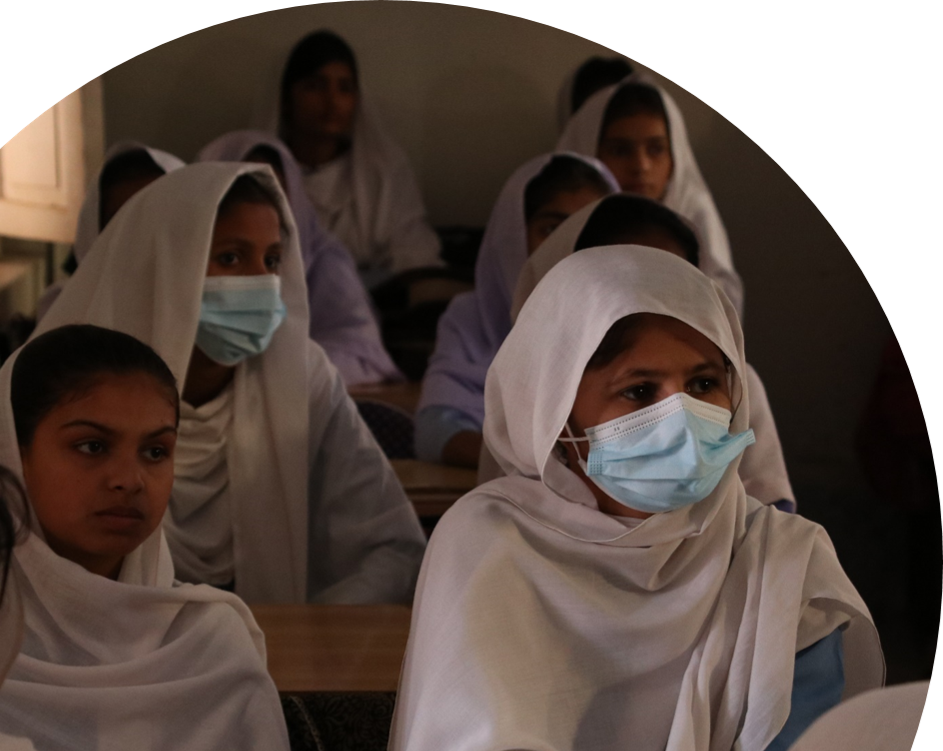 Addressing these issues requires a holistic approach with participation from girls, caregivers, and educators. Girls need to develop social-emotional skills and an understanding of their rights. Parents need to advocate for their daughters’ education. Educators need to develop more gender equitable and aspirational learning environments and build partnerships with families.
Addressing these issues requires a holistic approach with participation from girls, caregivers, and educators. Girls need to develop social-emotional skills and an understanding of their rights. Parents need to advocate for their daughters’ education. Educators need to develop more gender equitable and aspirational learning environments and build partnerships with families.
The Project
Girl Rising’s Kaavish (“effort”) program develops adolescents’ voice, agency and leadership skills through a story-based curriculum focusing on SEL, mental health, gender stereotypes, and menstrual health. This two-year program takes place in Pakistan’s Khairpur district and engages with mothers and teachers to build safe spaces for adolescent girls. The first year focuses on knowledge and skill building for adolescent girls, along with building gender responsive attitudes in teachers and mothers. In the second year, girls develop leadership skills to lead community groups, youth clubs, and school-based interventions. A peer-led leadership model promotes self-sufficiency for women and girls. The project also engages with boys and men to create an environment in which girls can thrive.
Girl Rising’s storytelling-based curriculum for both formal and non-formal educational settings addresses gender stereotypes and builds adolescent SEL. It includes a series of structured weekly sessions on the themes of self-awareness, aspirations and dreams, goal setting, understanding of gender bias, knowledge of rights, and establishing a support system. These sessions are facilitated by teachers trained by Girl Rising. By learning the stories of girls who overcame barriers, adolescents will be able to set personal goals and build the confidence to accomplish them. Teachers have reported that implementing this curriculum has helped them improve their teaching methodology and develop a greater sense of the challenges adolescents face. Mental health management and menstrual hygiene will also be incorporated into the curriculum to increase the relevance of the content for its target audience.
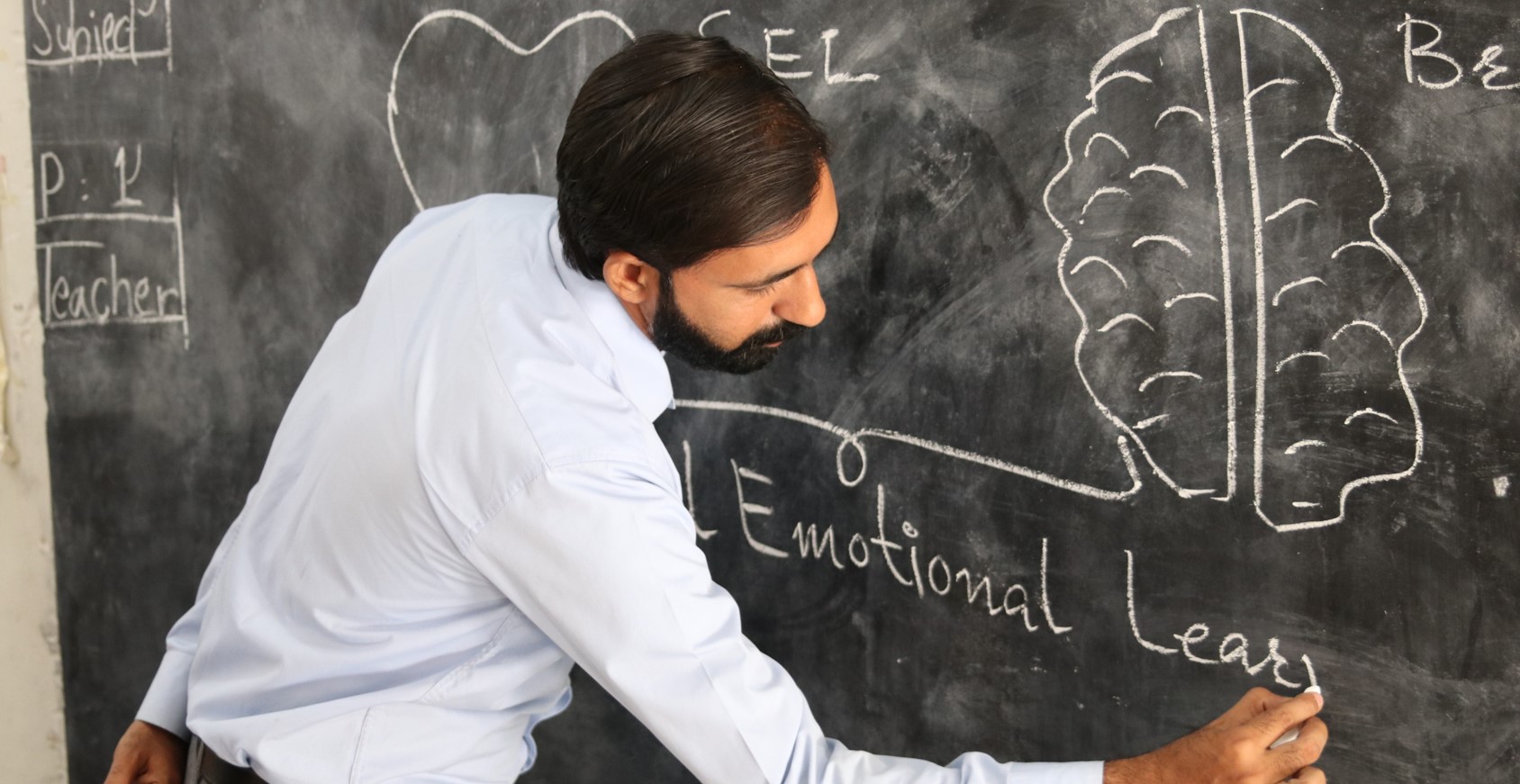
The Key Components of this Program are:
Curriculum Adaptation: At the beginning of the project, a thorough review of Girl Rising Pakistan’s gender and SEL curriculum will be carried out to incorporate themes of mental health and menstrual health and hygiene. The exercise will be carried out in consultation with local partnering organizations to ensure contextual relevance. Conducted over a 12-week period, stories of inspiring role models in the form of short videos and narrative essays will be a strong feature of the curriculum.
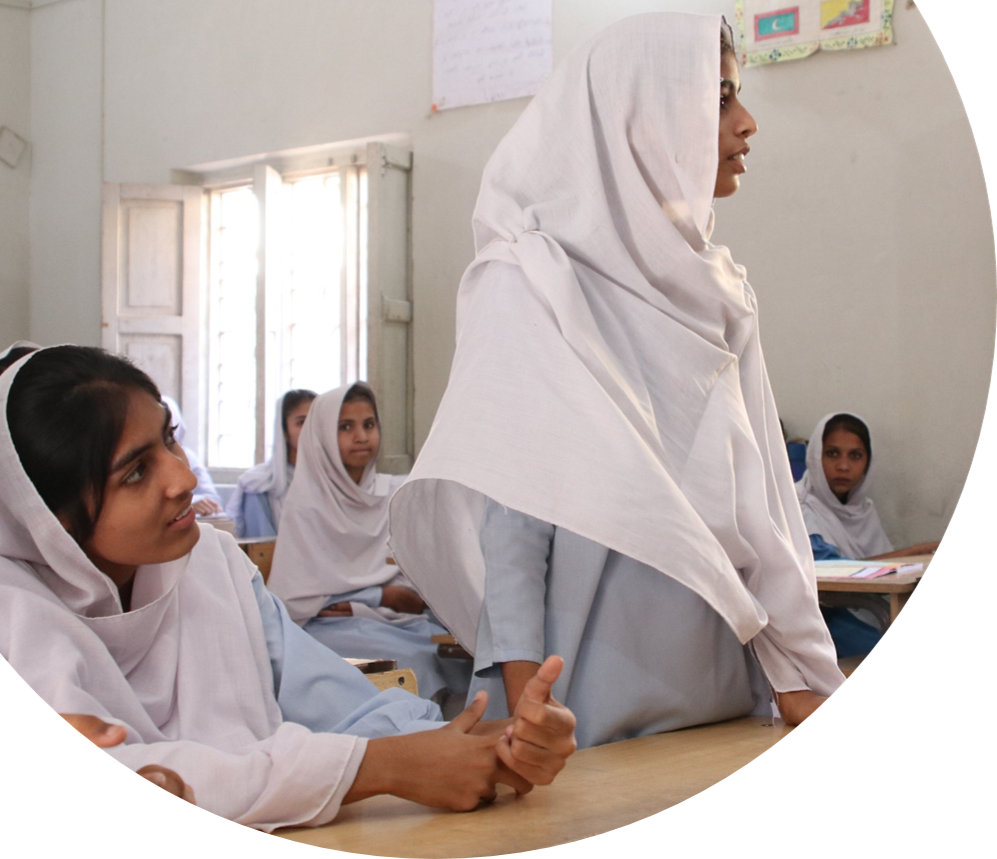 Teacher Training: Over the course of two years, multiple groups of teachers from six government schools will be trained to implement the Girl Rising curriculum in their classrooms. In the second year, a select group of these teachers will be trained as master trainers and engage parents in facilitating the SEL of their girls at home. These master trainers will mentor and train other teachers in the same school and neighboring government schools/educational institutions to implement the curriculum in their classroom.
Teacher Training: Over the course of two years, multiple groups of teachers from six government schools will be trained to implement the Girl Rising curriculum in their classrooms. In the second year, a select group of these teachers will be trained as master trainers and engage parents in facilitating the SEL of their girls at home. These master trainers will mentor and train other teachers in the same school and neighboring government schools/educational institutions to implement the curriculum in their classroom.
Peer-led Leadership Model: A select group of girls will be trained to become Girl Icons and lead peer-to-peer learning activities on SEL and academic issues under the supervision of master trainers. These activities will be held at youth clubs formed in consultation with teachers, adolescents participating in the program, and their parents. The youth clubs will be formed both at the school level and in community-based settings. Exposure visits will be arranged for the Girl Icons to acquaint them with various youth-led activities in the city/province. In addition, motivational speakers will be invited to the youth clubs to mentor young people.
Parents and Community Engagement: In parallel to curriculum implementation in schools, groups of mothers (fathers where possible) will be engaged in a series of sessions that will equip them with the appropriate strategies to facilitate their children’s SEL and understand the gender bias. Mothers will learn key elements of discussing the importance of education and other social issues with their children and creating safe spaces of interaction at home. These mothers, the Girl Icons, and master trainers will form a nexus of learning. They will be trained to build on each other’s efforts and support inter-group activities to inspire action towards achieving educational equity and gender responsiveness in their communities beyond the life of this project.
Impact:
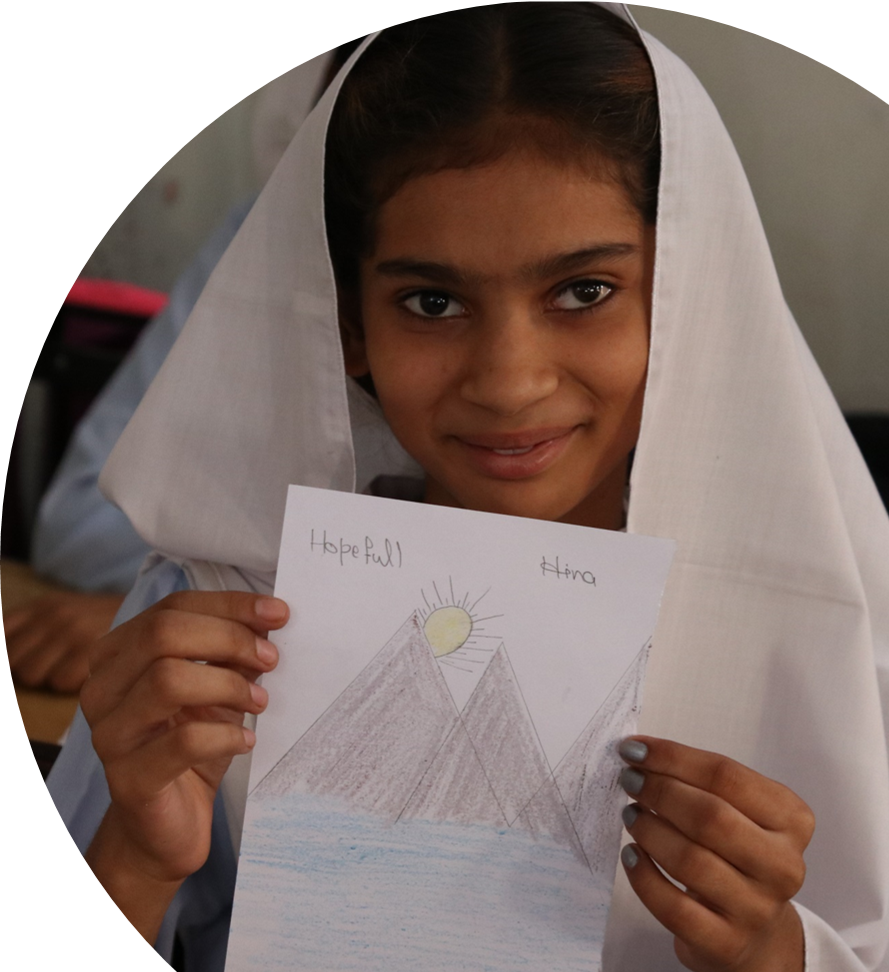 Girl Rising’s Kaavish Program will reach 500 adolescent girls and 100 adolescent boys from six government schools in the district of Khairpur, Sindh through weekly sessions of the Girl Rising curriculum. Thirty female teachers and 10 male teachers in these schools will be trained to deliver the Girl Rising curriculum sessions, and 300 mothers and 100 fathers will be directly approached to participate in the program’s community-based activities. In two years, 500 adolescent girls and 330 women (mothers and teachers) will be directly impacted by the program. In total, 1,040 individuals (600 adolescents, 40 teachers, 400 parents) will benefit directly.
Girl Rising’s Kaavish Program will reach 500 adolescent girls and 100 adolescent boys from six government schools in the district of Khairpur, Sindh through weekly sessions of the Girl Rising curriculum. Thirty female teachers and 10 male teachers in these schools will be trained to deliver the Girl Rising curriculum sessions, and 300 mothers and 100 fathers will be directly approached to participate in the program’s community-based activities. In two years, 500 adolescent girls and 330 women (mothers and teachers) will be directly impacted by the program. In total, 1,040 individuals (600 adolescents, 40 teachers, 400 parents) will benefit directly.
Sixty girls out of 500 who participate in the Girl Rising weekly sessions will be mentored to become Girl Icons to lead youth clubs, engaging at least 600 other girls and their families. Twenty out of 40 trained teachers will receive further training to mentor at least 100 teachers (80 female, 20 male) to implement the Girl Rising curriculum with their students. Considering Khairpur district’s average household has four children, at least 1,200 children (600 girls, 600 boys) will be indirectly impacted by the project through the learning and knowledge imparted to them by their parents directly participating in the Girl Rising program. These parents will further reach out to at least 100 mothers and 50 fathers in their community groups in the two-year project period. In two years, 1,200 adolescent girls and 180 women will be indirectly impacted by the program. In total, 2,050 individuals will benefit indirectly: 1,800 adolescents,100 teachers, and 150 parents.
On an annual basis, 515 women and girls will directly benefit in the first year (300 girls, 200 mothers, and 15 female teachers) and 590 will benefit indirectly (500 girls, 50 mothers, and 40 female teachers). In the second year, 315 women and girls will directly benefit (200 girls, 100 mothers, and 15 female teachers) and 790 will benefit indirectly (700 girls, 50 mothers, and 40 female teachers).
Girl Rising will work with Husn-e-Afroz Memorial Trust (HAMT), a women-led nonprofit organization that brings sustainable change in Khairpur by providing quality education to adolescents focusing on their socio-emotional development, engaging their families and the larger community to change discriminatory social norms. The curriculum targets adolescents 10 – 16 years of age (grades 5 – 10). For this project, HAMT will work in close collaboration with Girl Rising to strengthen the existing curriculum by adding content on mental health and menstrual hygiene, train project beneficiaries in government schools and community settings, and provide on-the-ground support in monitoring and evaluating project progress. HAMT’s staff will receive consistent mentoring and training from Girl Rising throughout the project cycle to manage activities on the ground.
Selection:
The girls enrolled in the HAMT adopted schools will be selected based on their age and grade level. Girl Rising and HAMT teams jointly organize orientation sessions for teachers to develop an in-depth understanding of the project and curriculum. The teachers are selected based on their interest and understanding of the issues and their commitment to become part of the program. Project monitoring officers will reach out to the mothers of the participating girls. The mothers will be given an orientation on the holistic nature of the project and their role as key contributors.
Monitoring and Evaluation:
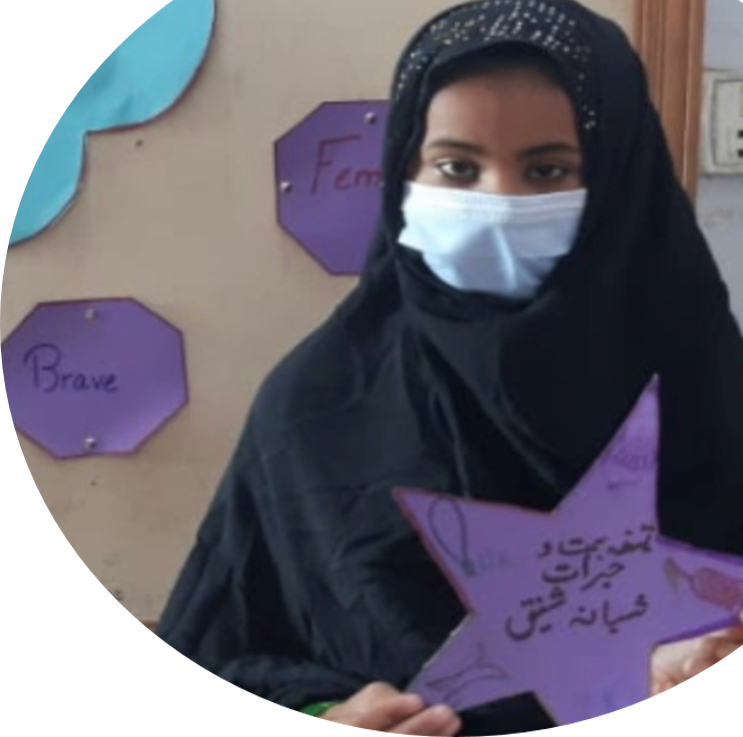 Girl Rising’s monitoring, evaluation and learning (MEL) framework measures intended outcomes of the curriculum implementation with teachers, students and parents through baseline and endline data collection. This involves a survey, interview and focus group. In line with Girl Rising’s emphasis on storytelling, narrative approaches inform the qualitative data collection methods. The framework has been piloted and tested in three contexts, including two rounds of implementation in Pakistan. This MEL framework will be adapted in alignment with the intended outcomes of this project which will include review of quantitative and qualitative instruments and data collection methods.
Girl Rising’s monitoring, evaluation and learning (MEL) framework measures intended outcomes of the curriculum implementation with teachers, students and parents through baseline and endline data collection. This involves a survey, interview and focus group. In line with Girl Rising’s emphasis on storytelling, narrative approaches inform the qualitative data collection methods. The framework has been piloted and tested in three contexts, including two rounds of implementation in Pakistan. This MEL framework will be adapted in alignment with the intended outcomes of this project which will include review of quantitative and qualitative instruments and data collection methods.
A baseline assessment will be conducted at the beginning of the project at the level of teachers, students and parents. A midline assessment will be carried out with teachers at the end of the teachers training to assess the quality of the training itself.
“Survival rate of girls in schools” will be measured as an overall education outcome for the project. Survival rate will be calculated by dividing the number of new entrants in a grade in year one and year two of the project by the number of students who enrolled in the previous grade the previous year. HAMT has systems in place to record and track school enrollment and retention across grades 5 – 10 in the six government schools participating in this project.
A project monitoring plan will be developed at the start of the project to determine key data points, develop monitoring tools and distribute responsibilities across team members. Case studies of adolescent girls, teachers and mothers challenging gender stereotypes in their communities and creating safe spaces for youth will be documented on an ongoing basis as a tool to track and record project progress. At the end of year one, a learning exercise will be held to reflect on the strengths and shortcomings of project implementation. This will be incorporated in the project plan for year two.
Endline assessments will be conducted within two weeks of completion of key project activities related to curriculum implementation, youth and parent engagement using quantitative and qualitative data collection methods.
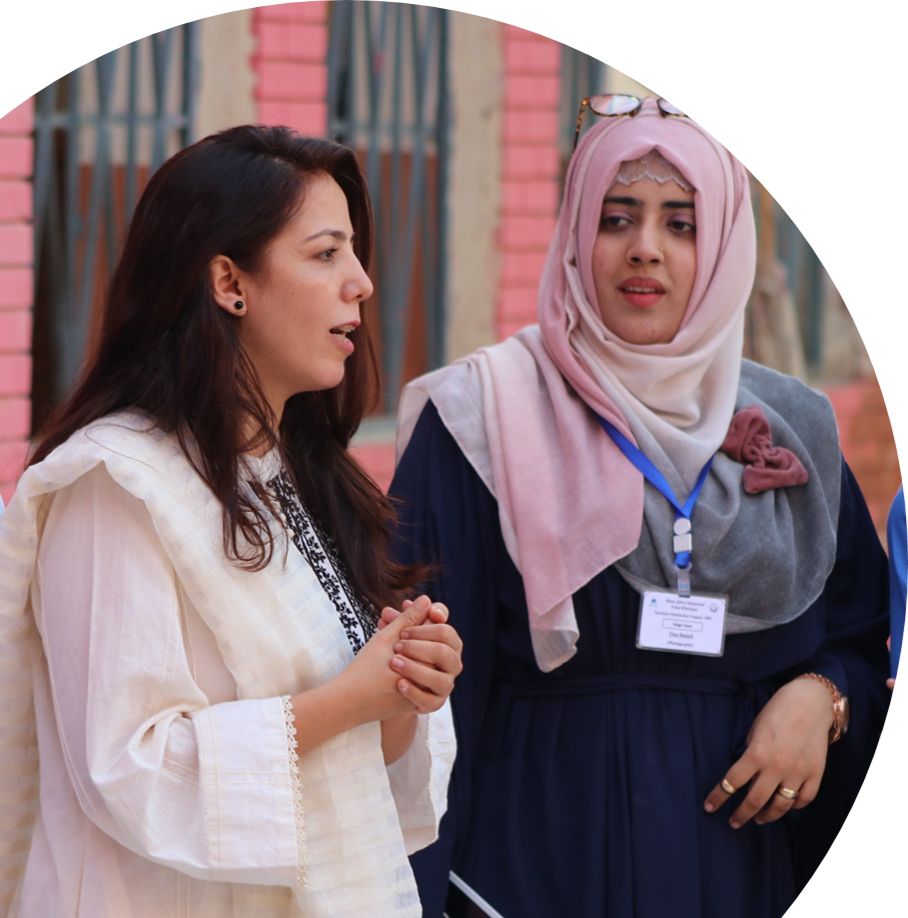 Data from baseline and endline assessment will be analyzed and correlated in the form of a final evaluation report at the end of the two-year project. This will reflect achievements of the overall project outcomes for teachers, youth and parents.
Data from baseline and endline assessment will be analyzed and correlated in the form of a final evaluation report at the end of the two-year project. This will reflect achievements of the overall project outcomes for teachers, youth and parents.
The long term vision for Kaavish is to build a growing and self-sustaining community of changemakers who continue to remove barriers to girls’ education in Pakistan so that young women can pursue their highest aspirations, and so that communities benefit from the long-lasting ripple effects of girls’ education. By growing a community of Girl Icons, building educator capacity, empowering HAMT and other like-minded organizations to lead gender equity programs, and facilitating a network of advocates over a period of 3 – 5 years, Girl Rising will empower the local community to sustain this work over the long-term.
Year 1 – Direct Impact: 515 (300 girls, 200 mothers, 150 female teachers); Indirect Impact: 590 (500 girls, 50 mothers, 40 female teachers)
Year 2 – Direct Impact: 315 (200 girls, 100 mothers, 15 female teachers); Indirect Impact: 790 (700 girls, 50 mothers, 40 female teachers)
UN Sustainable Development Goals
![]()
![]()
Questions for Discussion
- Why do you think it is important that both teachers and parents are included?
- Describe how this project has a built-in “ripple effect.”
- How do you think the broader community, including boys, benefits from this program?
How the Grant Will be Used
Together Women Rise’s grant of $49,995 over two years will help fund the following:
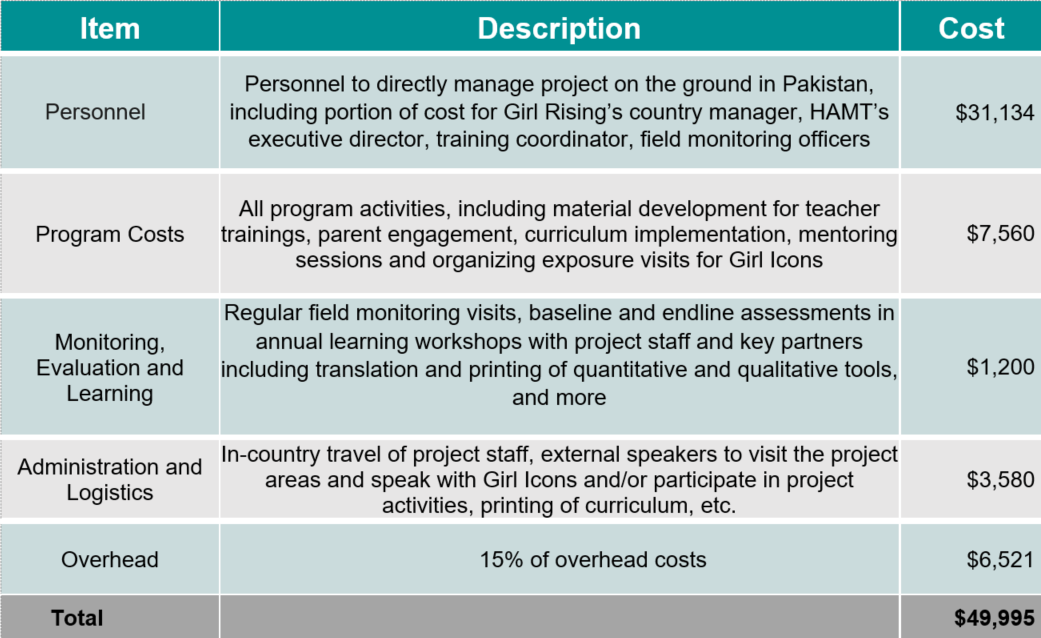
Why We Love This Project/Organization
We love that teachers grow in their craft, and the project offers some education for parents to support girls’ education. A 24-session curriculum offers great impact. Perhaps the most significant impact is in changing attitudes around girls’ education, child marriage, and marital violence. This project adds menstrual health and mental health to the curriculum.
Evidence of Success
An extensive evaluation of Girl Rising’s program over two years in India demonstrated that 90 percent of boys and girls reported that the program helped them talk to their family about the issues girls face, 87 percent of adolescents reported that the program motivated them to take action to address those issues, and 92 percent reported that the program helped them plan their future goals. Teachers shared the Girl Rising curriculum with their students’ families and as a result were able to convince parents to keep their daughters in school. The information gleaned from this program significantly contributed to the planning and implementation of another Girl Rising program on gender and SEL delivered in seven countries, including Pakistan, over four years.
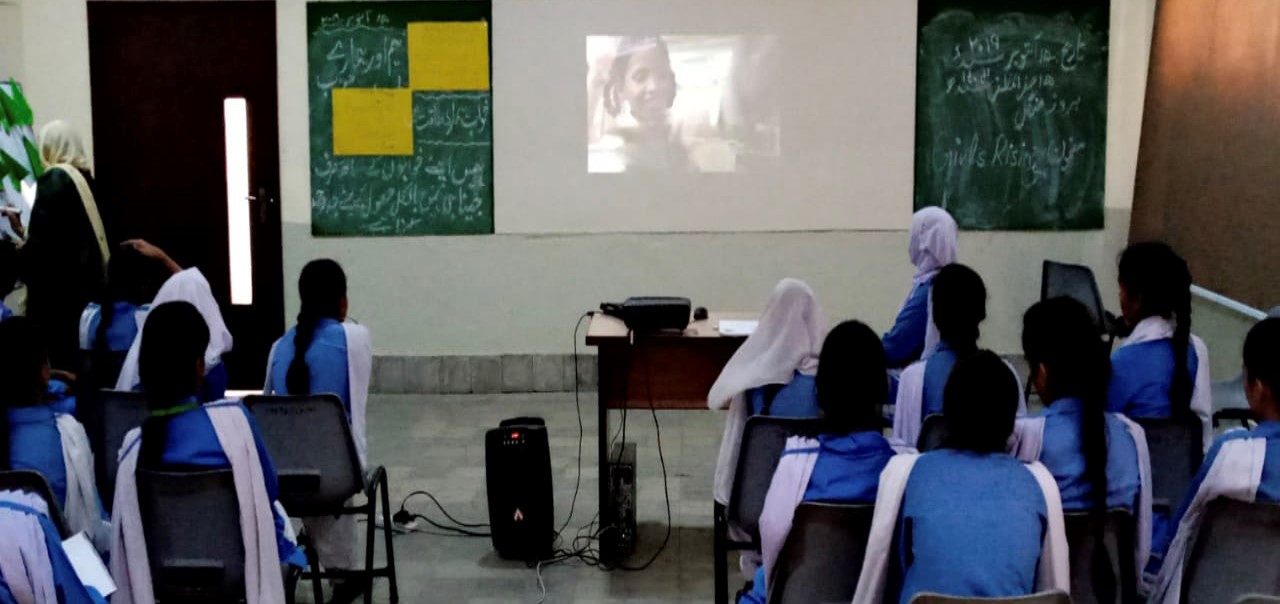
Two evaluations conducted in Pakistan, Thailand, Argentina, and Indonesia revealed positive changes in the attitudes of girls, boys, and teachers towards gender roles, self-efficacy and communication with peers and family. In Pakistan, the number of girls and boys who strongly agreed that only men should work outside the home fell 12 percent, and there was a 29 percent increase in students’ confidence to convince others about their aspirations.
In 2013, Girl Rising CEO Holly Gordon was awarded the UN Global Leadership Award. In
2021, Girl Rising CEO Christina Lowery was recognized with the Women’s Bond Club Betty Cook Award for her leadership in advancing and empowering other women.
Voices of the Girls
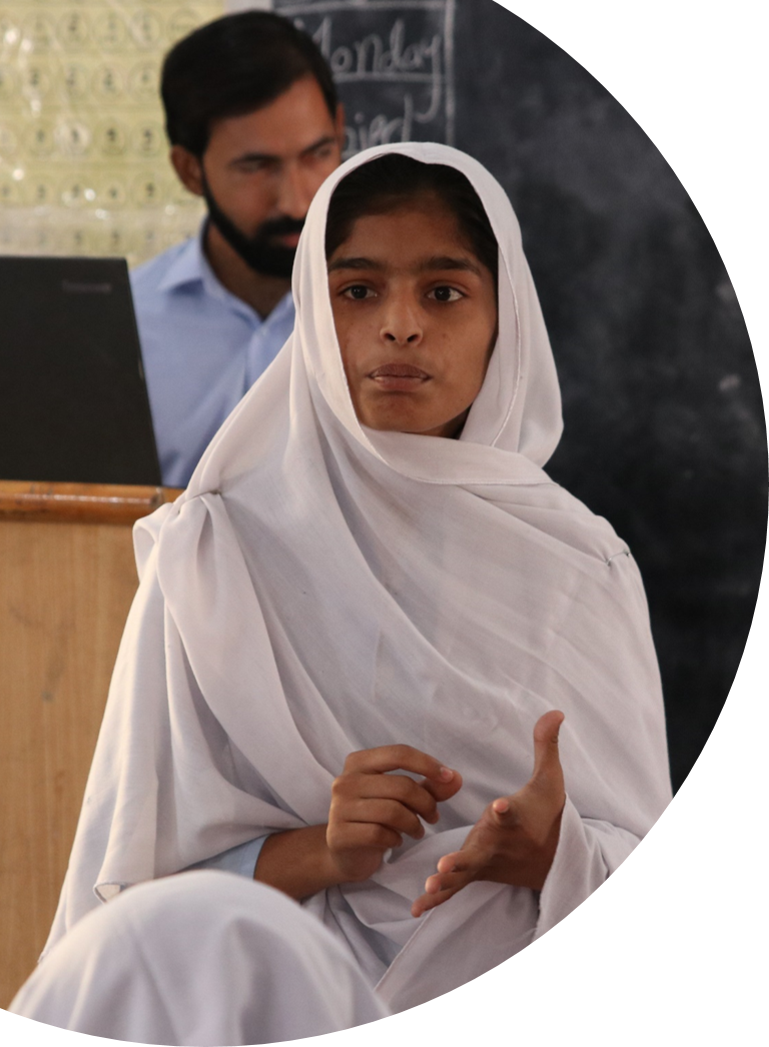 “I am a student of Star School Paras Bari and belong to the small village of Mansehra. I learnt how to fulfill my dreams through the Girl Rising Program by watching numerous stories of courageous and brave girls in this program. I learnt about the strength of the dreams. I learnt how to achieve my goals with utmost commitment and make my parents proud. My dream is to become a teacher. My dream is to continue my studies. I was told that I should study til 8th but I want to study more as this program motivated me a lot. I talked to my parents regarding continuation of my studies and asked for permission. My teacher is my role model and I also want to become a teacher. I learnt about the difference between gender and sex and about the rights of individual from this program. I will study and fulfill my dreams.” – Eman, Participant of Girl Rising Program, Pakistan
“I am a student of Star School Paras Bari and belong to the small village of Mansehra. I learnt how to fulfill my dreams through the Girl Rising Program by watching numerous stories of courageous and brave girls in this program. I learnt about the strength of the dreams. I learnt how to achieve my goals with utmost commitment and make my parents proud. My dream is to become a teacher. My dream is to continue my studies. I was told that I should study til 8th but I want to study more as this program motivated me a lot. I talked to my parents regarding continuation of my studies and asked for permission. My teacher is my role model and I also want to become a teacher. I learnt about the difference between gender and sex and about the rights of individual from this program. I will study and fulfill my dreams.” – Eman, Participant of Girl Rising Program, Pakistan
“I used to remain shy in my class, I was not good in many subjects but when I appeared in sessions conducted by Girl Rising last year, I felt confident. It seemed very useful to me when I identified my strengths and cultivated a better understanding of ways to use these strengths to overcome challenges in my life.” – Moomal, class 8, Khairpur
About the Organization
Girl Rising was founded in 2010 as a documentary film and social action campaign company by Holly Gordon, Richard Robbins, Christina Lowery, and Tom Yellin. The original Girl Rising film and international programming began in 2013 with a USAID-funded program in India, the Democratic Republic of Congo, and Nigeria. In 2017, Girl Rising transitioned to a nonprofit and expanded program delivery to new countries. In 2021, Girl Rising delivered programming in collaboration with 100+ local partners in 12 countries, reaching more than 10 million adolescents and more than 30,000 teachers.
Girl Rising –
- Creates: films, media content, and educational resources.
- Collaborates: with local schools, community-based organizations, and educational organizations – to provide educational resources, training and mentoring, measurement and evaluation training, expanding networks, and in some cases providing financial resources.
- Activates: storytelling and media content encourage change, inspiring everyone from parents to presidents to support girls’ education.
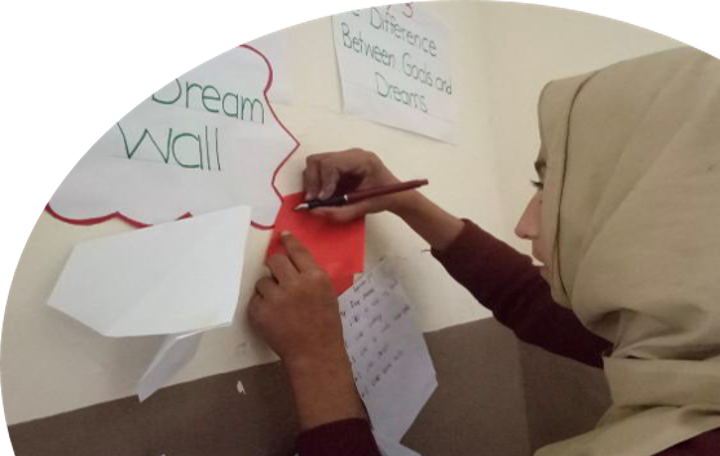 Girl Rising reaches adolescents ages 11 – 16 primarily residing or studying in rural communities. This year, programs are set to reach more than 8 million young people (70 percent girls and 30 percent boys). An estimated 80 percent of Girl Rising’s target population falls below the low income bracket, with some communities falling below the poverty line earning less than $1.90 per day. The unmet financial needs of these communities make education in schools and online learning unaffordable for families, which puts adolescents at a much greater risk of dropping out of school. To ensure sustainability of their programs, Girl Rising invests in educators’ skills development through training and in-service support. This year, an estimated 30,000 educators will be reached through Girl Rising’s teacher training.
Girl Rising reaches adolescents ages 11 – 16 primarily residing or studying in rural communities. This year, programs are set to reach more than 8 million young people (70 percent girls and 30 percent boys). An estimated 80 percent of Girl Rising’s target population falls below the low income bracket, with some communities falling below the poverty line earning less than $1.90 per day. The unmet financial needs of these communities make education in schools and online learning unaffordable for families, which puts adolescents at a much greater risk of dropping out of school. To ensure sustainability of their programs, Girl Rising invests in educators’ skills development through training and in-service support. This year, an estimated 30,000 educators will be reached through Girl Rising’s teacher training.
Since 2018, Girl Rising has provided gender and SEL-focused programs across four provinces in Pakistan, partnered with 23 local organizations, trained 462 educators, and delivered the curriculum to 9,000 adolescents across rural and urban settings. The four pillars of this model are:
- Contextualizing curriculum content to meet the needs of the target audience
- Meaningful engagement of young people and their parents to create a supportive learning environment
- Training teachers about self-awareness, gender, and SEL to build an in-depth understanding of these areas and equip them with the skills to deliver the curriculum in their classrooms
- Using culturally adapted stories of local and international role models, in the form of short videos or narrative essays, inspiring young people to identify barriers to their growth, build voice and agency to address those barriers, and learn the skills to tell their stories.
Girl Rising’s program depends on collaborations with local partners over a multi-year period. The goal is to build partners’ capacity so that their ability to create change continues beyond the life of the formal partnership.
Girl Rising will establish a formal partnership with HAMT, a dynamic women-led, non-profit organization in Khairpur in the province of Sindh. HAMT was founded in 2008 by one of Sindh’s most progressive members of The National Assembly. Among Pakistan’s 101 district mayors in 2001, she became the district mayor of Khairpur, one of the only two women district mayors in the country. HAMT was founded to bring sustainable change in the under-served city of Khairpur by providing quality education to adolescents focusing on their social-emotional development and engaging their families and the larger community to change discriminatory social norms. Under a public-private partnership initiative, HAMT adopted six government schools in Khairpur district to improve curriculum implementation and teacher training and to provide infrastructural support. HAMT continuously mobilizes groups of women and men in the community to participate in school enrollment campaigns and raise funds locally to support deserving students’ academic expenses. HAMT’s strong ties with the district and provincial education departments have allowed it to partner with organizations like Girl Rising in the past to implement a variety of curricula on gender sensitization and life skills based education.
Where They Work
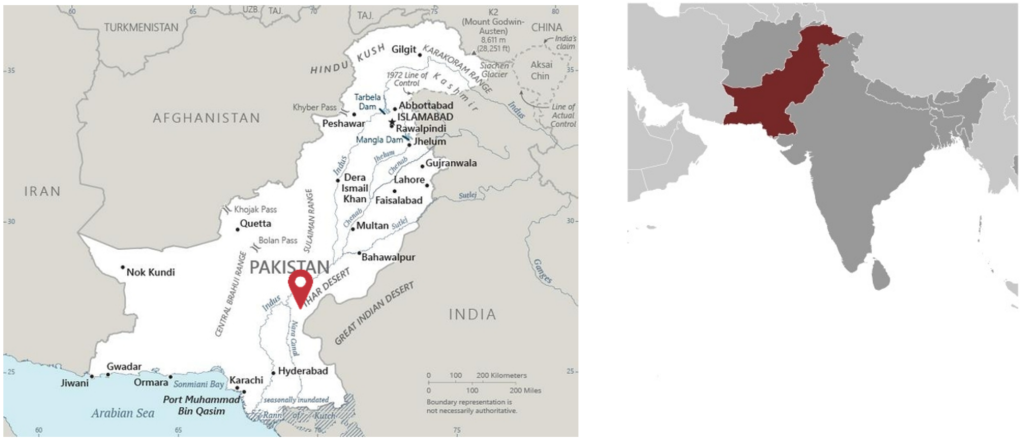
This project takes place in the underserved Khairpur district of Sindh, Pakistan. Pakistan is located in Southern Asia and shares borders with Afghanistan, China, and India. The total population is nearly 248 million (2023 estimate.) The median age is 20.2 years, and the average life expectancy is 66.
Pakistan faces many internal and external conflicts, including a fragile economy, extremism, and intolerance of diversity and dissent. Active militant groups contribute to a high level of insecurity and tension. Corruption and violence are the norm. Recent flooding across the country caused significant damage and significantly challenged the country’s agriculture and health sectors. These floods showed Pakistan’s vulnerability to climate disasters as well as ongoing issues with governance and economic stability.
Half of Pakistanis work in agriculture, but the majority of the country’s GDP comes from services such as banking and information technology. As a result, many people are moving to urban areas in search of jobs. Almost all Pakistanis are Muslim and only 59 percent are literate. Human development lags in most of the region.
A Closer Look at Girls’ Education in Pakistan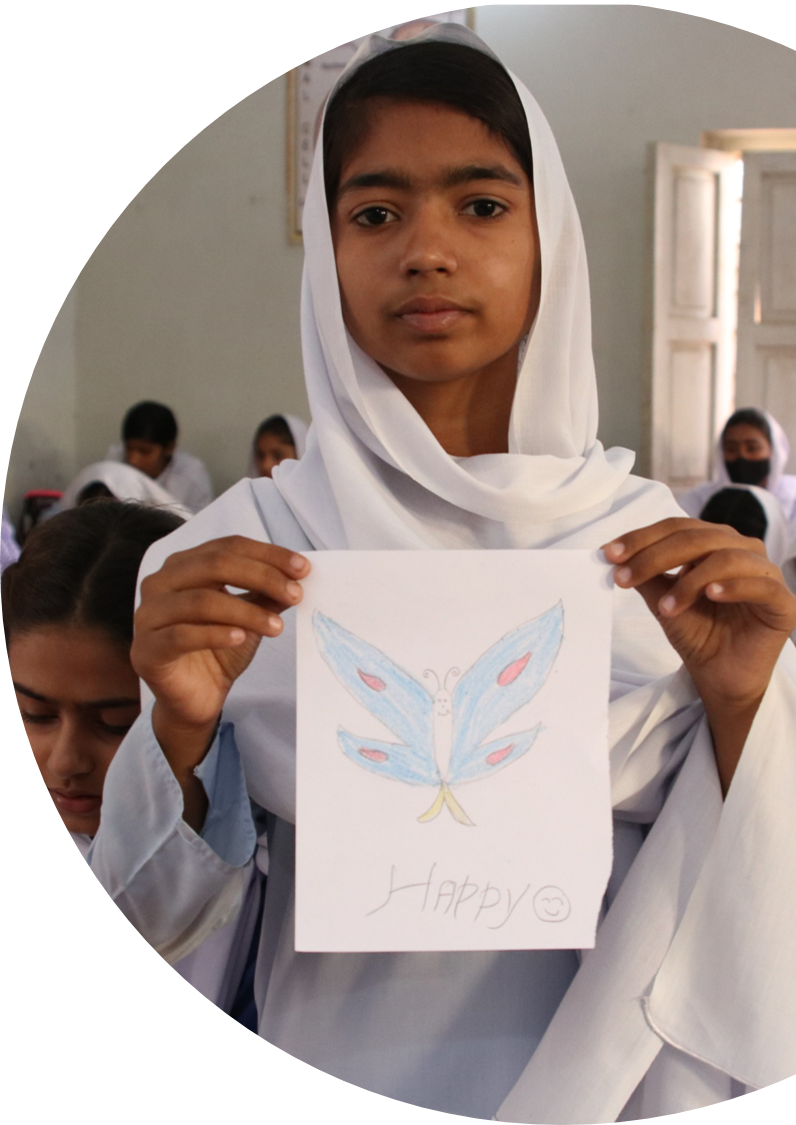
In Pakistan, 44 percent of boys and 56 percent of girls do not attend school. One out of five girls is married by the age of 18 and firmly enmeshed in domestic life from then on. Three percent are married by age 15. Most schools in Pakistan are either all boys or all girls, with coeducation being a modern concept. The government of Pakistan guarantees the right for all children ages 5 to 16 to go to school, but funding for education is extremely low. As a result, schools struggle and teachers are often underqualified.
Girls in rural settings are at a greater disadvantage when it comes to getting an education. Often there are no available facilities, let alone teachers or supplies, and the cost of transportation makes it prohibitive to attend. Some rural towns are nearly 100 miles from the nearest school. The families living in these areas are often poor. Although the government-owned schools in Pakistan are free, the families must buy books, paper, and other school supplies. The average national income is $1,500, making it almost impossible to pay for education-related expenses.
Due to the socio-cultural issues and a lack of access to education, women make up only 39 percent of the labor force in Pakistan. Those with a primary education make about half of what men earn in Pakistan, but with a secondary education, these women can earn 70 percent of what men earn.
Source Materials
https://www.cia.gov/the-world-factbook/countries/pakistan
https://www.worldeconomics.com/Demographics/Median-Age/Pakistan.aspx
https://reliefweb.int/report/pakistan/pakistan-2023-ifrc-network-country-plan-maapk002#:~:
https://www.borgenmagazine.com/top-10-facts-about-girls-education-in-pakistan/
https://edufinance.org/latest/blog/2021/empowering-girls-through-education-in-pakistan

